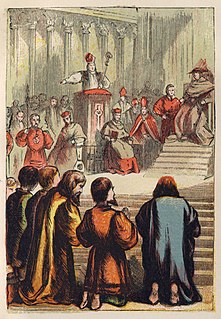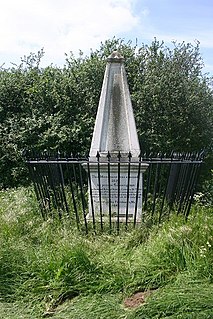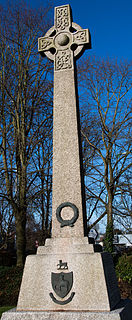Related Research Articles

Reginald Pole was an English cardinal of the Catholic Church and the last Catholic archbishop of Canterbury, holding the office from 1556 to 1558, during the Counter-Reformation.

Edmund Bonner was Bishop of London from 1539 to 1549 and again from 1553 to 1559.

Robert Barnes was an English reformer and martyr.

Hugh Latimer was a Fellow of Clare College, Cambridge, and Bishop of Worcester during the Reformation, and later Church of England chaplain to King Edward VI. In 1555 under the Catholic Queen Mary I he was burned at the stake, becoming one of the three Oxford Martyrs of Anglicanism.
Lawrence Saunders was an English Protestant martyr whose story is recorded in Foxe's Book of Martyrs.

Rowland Taylor was an English Protestant martyr during the Marian Persecutions.

John Bradford (1510–1555) was an English Reformer, prebendary of St. Paul's, and martyr. He was imprisoned in the Tower of London for alleged crimes against Queen Mary I. He was burned at the stake on 1 July 1555.
Robert Aldrich or Aldridge was Bishop of Carlisle in the reigns of Henry VIII, Edward VI and Mary.
Ralph Baines or "Bayne" was the last Roman Catholic Bishop of Lichfield and Coventry, in England.
Events from the 1550s in England. This decade marks the beginning of the Elizabethan era.

Richard Bertie was an English landowner and religious evangelical. He was the second husband of Catherine Willoughby, 12th Baroness Willoughby de Eresby, Duchess Dowager of Suffolk and a woman whom Henry VIII was considering as his seventh wife shortly before his death; she also received a proposal from the King of Poland.
Joan Waste or Wast was a blind woman who was burned in Derby for refusing to renounce her Protestant faith.
Walter Haddon LL.D. (1515–1572) was an English civil lawyer, much involved in church and university affairs under Edward VI, Queen Mary, and Elizabeth I. He was a University of Cambridge humanist and reformer, and was highly reputed in his time as a Latinist. He sat as an MP during the reigns of Mary and Elizabeth. His controversial exchange with the Portuguese historian Jerónimo Osório attracted international attention partly on account of the scholarly reputations of the protagonists.

The Coventry Martyrs were a disparate group of Lollard Christians executed for their beliefs in Coventry between 1512 and 1522 and in 1555. Eleven of them are commemorated by a six-metre-high (20 ft) monument, erected in 1910 in a public garden in the city, between Little Park Street and Mile Lane; and by a mosaic constructed in 1953 inside the entrance to Broadgate House in the city centre. Some of the streets in the city's Cheylesmore suburb are named after them.

St Edward's Passage, known in the 18th century as Chain Lane, is a Y-shaped alleyway in Cambridge, England, between King's Parade—opposite the main gate of King's College—and Peas Hill. It houses the entrance and churchyard of the Church of St Edward King and Martyr; the Cambridge Arts Theatre; several cottages; G. David, an independent bookshop run from the same building since 1896; a few businesses; and student accommodation. It is a narrow, dark lane, with riven-stone paving, which opens out onto the much wider and sunnier King's Parade.
Cornelius Bongey was an English Protestant martyr who was burnt at Coventry in September 1555.

Joyce Lewis or Jocasta Lewis was an English Protestant martyr.
Julins Palmer was an English Protestant martyr. His name Julins was apparently a form of Joscelin, and has been generally misspelt Julius.
References
- Creasy, E. S., Memoirs of Eminent Etonians: With Notices of the Early History of Eton College, R. Bentley, 1850.